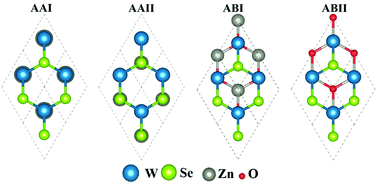ZnO/WSe2 vdW heterostructure for photocatalytic water splitting†
Abstract
Hydrogen production by water splitting using a particular photocatalyst has received extensive attention as a substitute for clean energy sources. The efficiency of water splitting strongly relies on the structural and electronic properties of the photocatalyst. In this study, the electronic and optical properties of ZnO/WSe2 heterobilayers were studied using the first-principles calculations. It is found that the direct band gap was spatially separated for the WSe2 and ZnO monolayers, forming a van der Waals (vdW) heterostructure with type-II alignment with electrons and holes. The charge transfer from ZnO to WSe2 resulted in a built-in electric field, improving the photocatalytic efficiency due to a better charge separation. The heterobilayers possessed a small carrier effective mass with high carrier mobility. The valence and conduction bands of the heterostructure perfectly engulfed the redox potentials of water. The heterobilayer exhibited a continuously tunable band gap under the biaxial strain. The heterostructure had a high absorption coefficient of up to 105 cm−1 both in the visible and ultraviolet light spectra, indicating that it could absorb photons with wavelengths of 400 to 760 nm. Such pronounced electronic and optical properties render the ZnO/WSe2 heterobilayers a promising photocatalyst for the water splitting reaction, not only in ultraviolet light but also in the visible light spectrum.



 Please wait while we load your content...
Please wait while we load your content...